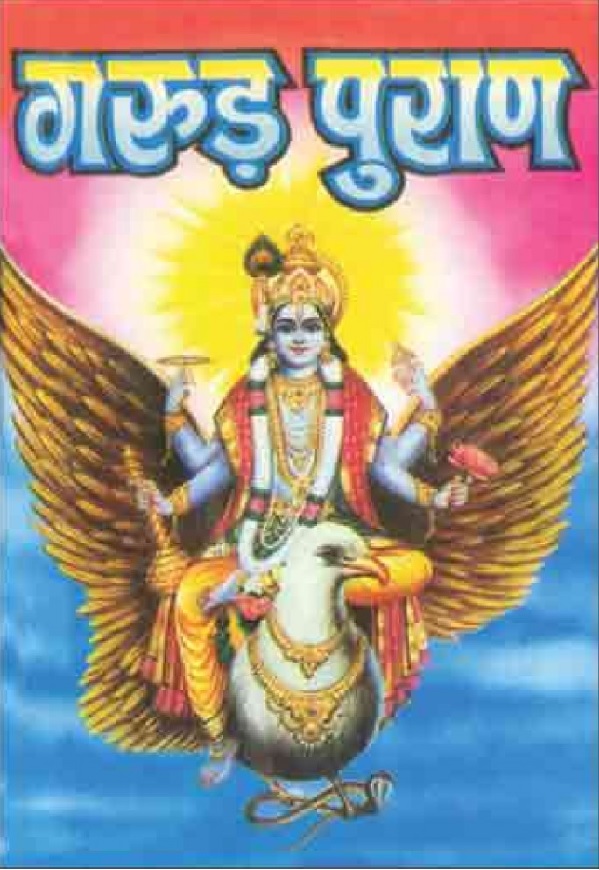मत्स्य पुराण
मत्स्य पुराण पुराण में भगवान श्रीहरि के मत्स्य अवतार की मुख्य कथा के साथ अनेक तीर्थ, व्रत, यज्ञ, दान आदि का विस्तृत वर्णन किया गया है। इसमें जल प्रलय, मत्स्य व मनु के संवाद, राजधर्म, तीर्थयात्रा, दान महात्म्य, प्रयाग महात्म्य, काशी महात्म्य, नर्मदा महात्म्य, मूर्ति निर्माण माहात्म्य एवं त्रिदेवों की महिमा आदि पर भी विशेष प्रकाश डाला गया
इस पुराण में सात कल्पों का कथन है, नृसिंह वर्णन से शुरु होकर यह चौदह हजार श्लोकों का पुराण है। मनु और मत्स्य के संवाद से शुरु होकर ब्रह्माण्ड का वर्णन ब्रह्मा देवता और असुरों का पैदा होना, मरुद्गणों का प्रादुर्भाव इसके बाद राजा पृथु के राज्य का वर्णन वैवस्त मनु की उत्पत्ति व्रत और उपवासों के साथ मार्तण्डशयन व्रत द्वीप और लोकों का वर्णन देव मन्दिर निर्माण प्रासाद निर्माण आदि का वर्णन है। इस पुराण के अनुसार मत्स्य (मछ्ली) के अवतार में भगवान विष्णु ने एक ऋषि को सब प्रकार के जीव-जन्तु एकत्रित करने के लिये कहा और पृथ्वी जब जल में डूब रही थी, तब मत्स्य अवतार में भगवान ने उस ऋषि की नांव की रक्षा की थी। इसके पश्चात ब्रह्मा ने पुनः जीवन का निर्माण किया। एक दूसरी मन्यता के अनुसार एक राक्षस ने जब वेदों को चुरा कर सागर में छुपा दिया, तब भगवान विष्णु ने मत्स्य रूप धारण करके वेदों को प्राप्त किया और उन्हें पुनः स्थापित किया।
वर्णित विषय
- कृष्णाष्टमी, गौरितृतीया, अक्षयतृतीया,सरस्वती, भीमद्वादशी आदि व्रत
- प्रयाग, नर्मदा, कैलास वर्णन
- राजधर्म
- शकुनशास्त्र
- शिल्पशास्त्र
- प्रतिमानिर्माण
- प्रतिष्ठापन विधि
- पुरुषार्थ
- गृहनिर्माण
- प्रकृति वर्णन
- ययाति चरित्र
- देवयानी कथानक
- सावित्री-उपाख्यान
- नरसिंहावतार का महत्व
- चन्द्रवंश, सूर्यवंश, यदुवंश, कुरुवंशान विवरण
- युग, कल्प आदि का विवरण
The Matsya Purana is one of the eighteen major Puranas (Mahapurana), and among the oldest and better preserved in the Puranic genre of Sanskrit literature in Hinduism. The text is a Vaishnavism text named after the half-human and half-fish avatar of Vishnu. However, the text has been called by the 19th-century Sanskrit scholar Horace Hayman Wilson, “although a Shaivism (Shiva-related) work, it is not exclusively so”; the text has also been referred to one that simultaneously praises various Hindu gods and goddesses.
The Matsya Purana has survived into the modern era in many versions, varying in the details but almost all of the published versions have 291 chapters, except the Tamil language version, written in Grantha script, which has 172 chapters.
The text is notable for providing one of earliest known definition of a Purana genre of literature. A history written with five characteristics is called a Purana, states Matsya Purana, otherwise it is called Akhyana. These five characteristics are cosmogony describing its theory of primary creation of the universe, chronological description of secondary creations wherein the universe goes through the cycle of birth-life-death, genealogy and mythology of gods and goddesses, Manvantaras, legends of kings and people including solar and lunar dynasties.[8]
The Matsya Purana is also notable for being encyclopedic in the topics it covers.[9] Along with the five topics the text defines a Purana to be, it includes mythology, a guide for building art work such as paintings and sculpture, features and design guidelines for temples, objects and house architecture (Vastu-shastra), various types of Yoga, duties and ethics (Dharma) with multiple chapters on the value of Dāna (charity), both Shiva and Vishnu related festivals, geography particularly around the Narmada river, pilgrimage, duties of a king and good government and other topics
प्रथम भाग
[YUMPU epaper_id=”10″ width=”512″ height=”384″]
द्वितीय भाग
[YUMPU epaper_id=”11″ width=”512″ height=”384″]








There are no reviews yet.